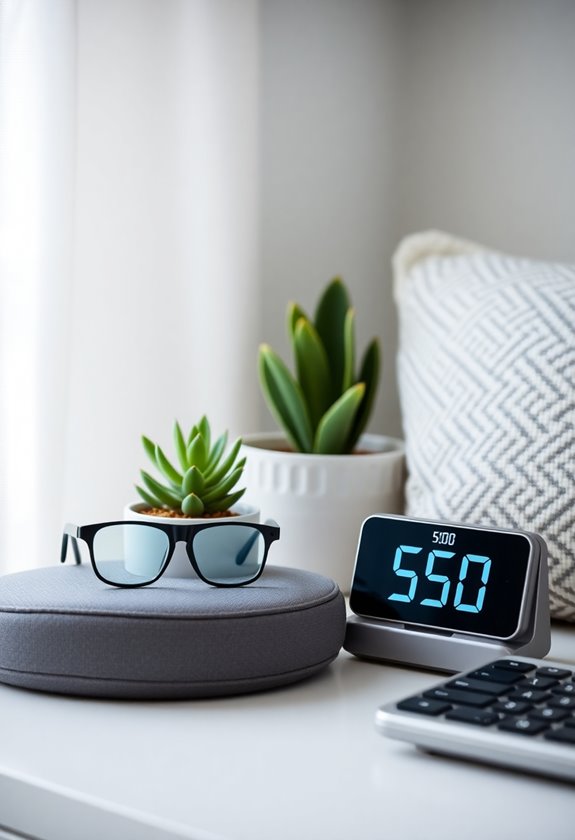You can reduce your screen time gradually by implementing five gentle methods that won't leave you feeling deprived. Start by designating device-free zones in your home, like bedrooms and dining areas, while using tracking apps to monitor your digital habits. Replace screen activities with outdoor adventures, family sports, or nature walks to stay engaged without devices. Schedule regular screen breaks using the 20-20-20 rule, and create dedicated tech-free family time through activities like board games and cooking together. These practical adjustments will help you develop a healthier relationship with technology, and there's much more to discover about each approach.
Highlights
- Start with the 20-20-20 rule: Look at something 20 feet away for 20 seconds every 20 minutes of screen time.
- Create device-free zones in bedrooms and dining areas, with designated storage spots for phones and tablets.
- Replace screen activities with outdoor alternatives like family sports, nature walks, or gardening projects.
- Use tracking apps to monitor screen time and set gentle daily limits without being too restrictive.
- Schedule regular tech-free family activities like board games, crafting, or cooking sessions together.
Start With Device-Free Zones
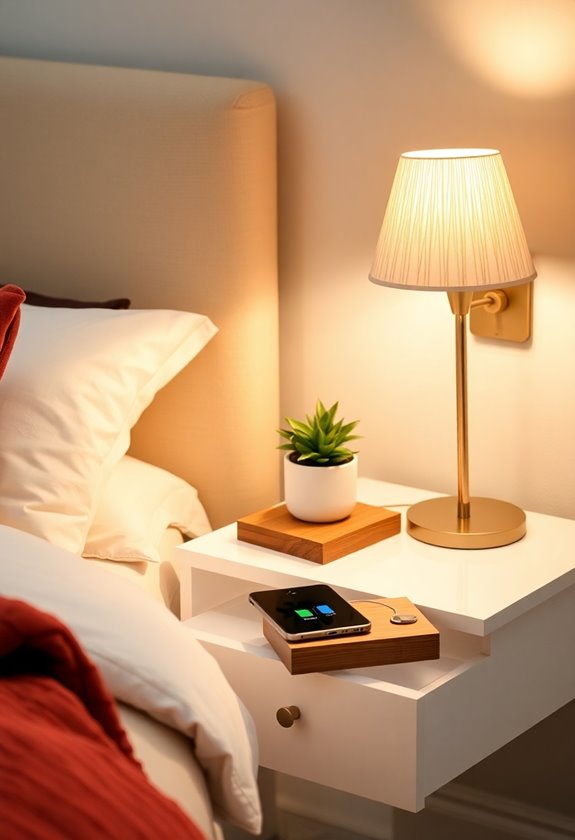
In today's hyper-connected world, establishing device-free zones in your home creates essential boundaries for healthier digital habits. Start by designating specific areas where devices aren't welcome, such as dining rooms, bedrooms, and living spaces, then establish consistent rules that apply to everyone in your household. Research shows that excessive screen use contributes to increased stress and anxiety levels in both children and adults. Consider keeping stress relief tools like squeeze balls in your device-free zones to help family members cope with digital withdrawal.
You'll want to:
- Remove devices completely from designated zones
- Create dedicated storage spots for phones and tablets
- Set up screen-free mealtimes and pre-bedtime periods
- Use tracking apps to monitor your family's device usage
- Move distracting apps away from device home screens
These boundaries will help improve your sleep quality, promote more focused family interactions, and encourage screen-free activities that enrich your daily routines while reducing unwanted distractions throughout your home.
Track Your Digital Diet
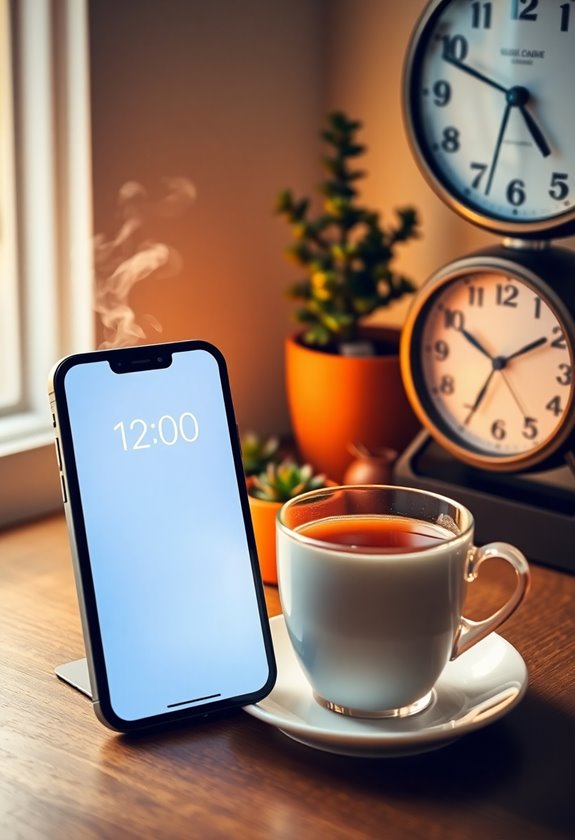
Understanding your digital consumption starts with effective tracking tools and strategies. You'll find powerful options in apps like RescueTime and Canopy that provide detailed reports on your screen usage patterns, while StayFree and RealizD let you set specific app limits to manage your time better.
Setting healthy boundaries with your devices can help reduce stress and anxiety associated with excessive screen time. To get the most from your tracking efforts, choose an app that aligns with your needs by looking for features like cross-device compatibility, detailed analytics, and customizable notification settings. You'll want to focus on establishing incremental screen time caps and identifying which apps consume most of your attention, using the data to make informed decisions about your usage patterns. By consistently monitoring your digital diet through built-in device features or third-party apps, you'll develop a clearer picture of your habits and opportunities for improvement.
Swap Screens for Outdoor Activities
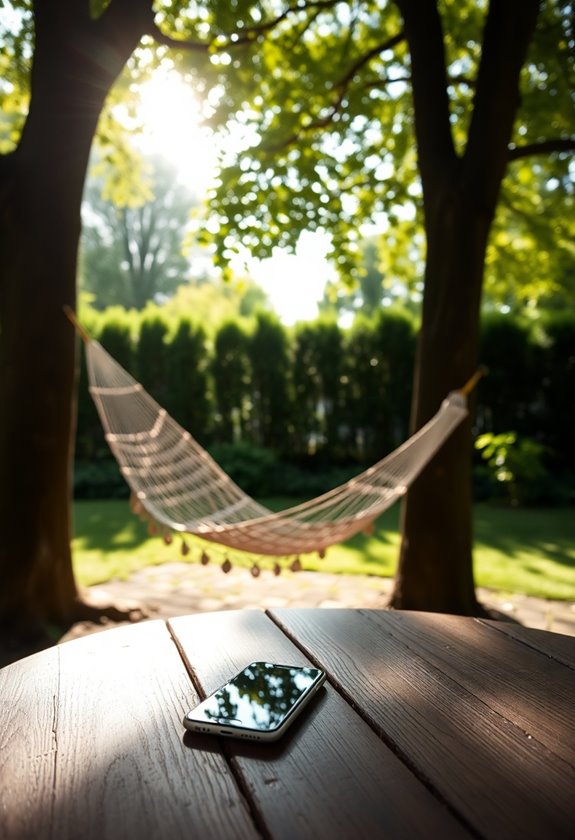
While tracking your screen time provides valuable insights, taking action means replacing digital activities with meaningful alternatives. You'll discover that outdoor activities offer remarkable benefits for both physical and mental well-being, from reducing stress to improving cardiovascular health. Local resources in Thunder Bay make outdoor engagement easily accessible. Consider using herbal supplements as a natural way to ease the transition away from screens and support relaxation during outdoor activities.
Transform your daily routine by incorporating these engaging outdoor alternatives:
- Organize family sports events that encourage teamwork and physical activity
- Create nature scavenger hunts to spark curiosity and environmental awareness
- Start a family garden to teach responsibility and patience
- Plan regular hiking or biking excursions on local trails
- Set up dedicated outdoor play spaces in your yard
You'll find that leading by example and providing proper equipment makes the shift smoother, while establishing media-free zones helps maintain healthy boundaries between screen time and outdoor activities.
Schedule Screen Breaks Daily

Taking regular breaks from screens throughout your day can dramatically improve both your productivity and well-being. You'll want to implement the 20-20-20 rule, which means looking at something 20 feet away for 20 seconds every 20 minutes while you're working at your computer. Brief disengagement from screens has been scientifically proven to reset your mental state and enhance performance.
Set up a consistent break schedule that includes both micro-breaks and longer 15-minute breaks, treating them as non-negotiable appointments in your daily routine. You can use productivity apps to track your screen time and send helpful reminders when it's time to step away. During these breaks, engage in active movements like stretching or walking, which will help reduce eye strain and improve your posture. Consider creating screen-free zones in your home or office to guarantee you're getting quality time away from devices.
Create Tech-Free Family Time
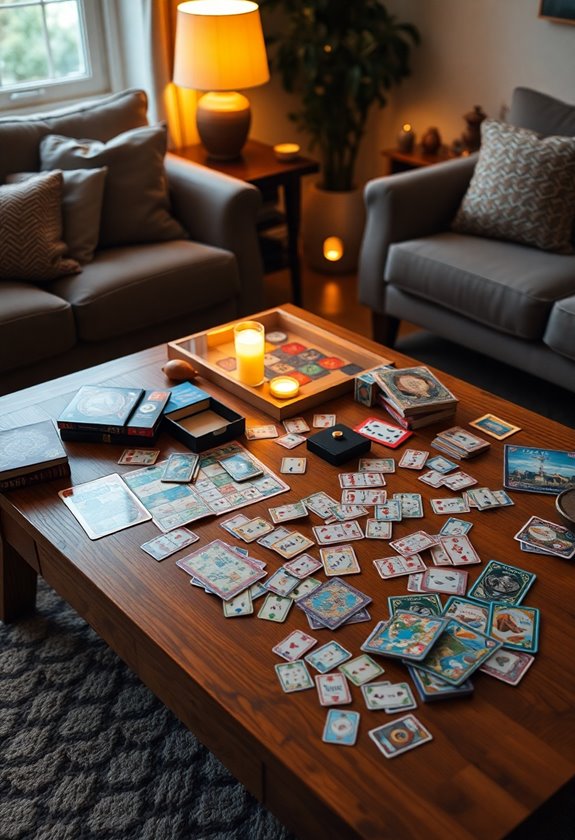
Creating meaningful tech-free family time requires a combination of clear boundaries and engaging alternatives to screen-based activities. You'll find success by designating specific areas in your home as tech-free zones while planning activities that naturally draw everyone away from their devices. These moments of shared experiences help build stronger emotional connections between family members.
- Plan weekly outdoor adventures like hiking or biking to create active family memories
- Set up a dedicated craft corner where everyone can engage in creative projects together
- Establish a regular family game night with board games and card games
- Create a cozy reading nook where family members can enjoy books side by side
- Schedule cooking sessions where everyone participates in meal preparation
Frequently Asked Questions
How Do I Manage Screen Time When Working Remotely Requires Constant Device Use?
Don't let screen time get the best of you while working from home. Start by implementing the 20-20-20 rule to protect your eyes, scheduling regular screen-free breaks throughout your day. Use built-in screen time tracking tools to monitor your usage, and create device-free zones for meals and relaxation. Set up automated notifications for breaks, and designate specific times for deep-focus work without distractions.
What Are Healthy Screen Time Limits for Different Age Groups?
Screen time limits vary considerably by age group. For infants under 18 months, you'll want to avoid screen time entirely except for video chats. Children aged 2-5 should have no more than one hour of high-quality programming daily with parental co-viewing. Elementary-age kids (5-12) shouldn't exceed two hours per day beyond homework, while teens can handle up to nine hours daily, though you'll need to verify it doesn't impact sleep or physical activity.
Can Blue Light Blocking Glasses Help Reduce Negative Effects of Screens?
While millions swear by blue light glasses, research doesn’t strongly support their effectiveness for reducing eye strain. You’ll find mixed evidence about their benefits, with most high-quality studies showing no significant difference between blue light blocking and regular lenses. They might help with sleep if you’re using screens before bedtime, but you shouldn’t rely on them as your primary solution for screen-related issues. Instead, it’s important to prioritize good screen habits, such as taking regular breaks, adjusting screen brightness, and maintaining proper posture. Additionally, consider incorporating natural fogfighting remedies, such as using artificial tears and practicing the 20-20-20 rule (looking at something 20 feet away for 20 seconds every 20 minutes). These habits can help alleviate eye strain without the need for blue light glasses.
How Can I Reduce Screen Time Without Affecting My Social Media Business?
You can maintain your social media business while reducing screen time by implementing strategic time blocks for content creation and engagement. Schedule dedicated posting times using tools like Planoly, batch-create your content in advance, and set specific windows for responding to comments and messages. Use built-in screen time trackers to monitor your usage, and focus on maximizing productivity during your allocated social media hours.
What Withdrawal Symptoms Might Occur When Drastically Reducing Screen Time?
Just as a diver can't surface too quickly, you shouldn't abruptly cut your screen time without expecting some ripples in your daily life.
You'll likely experience:
- Irritability and mood swings that can affect your concentration
- Physical symptoms like headaches and disrupted sleep patterns
- Strong urges to check your devices, similar to breaking any habit
- Temporary anxiety and restlessness while your brain adjusts to the change
These symptoms typically peak within the first few days before gradually subsiding.




